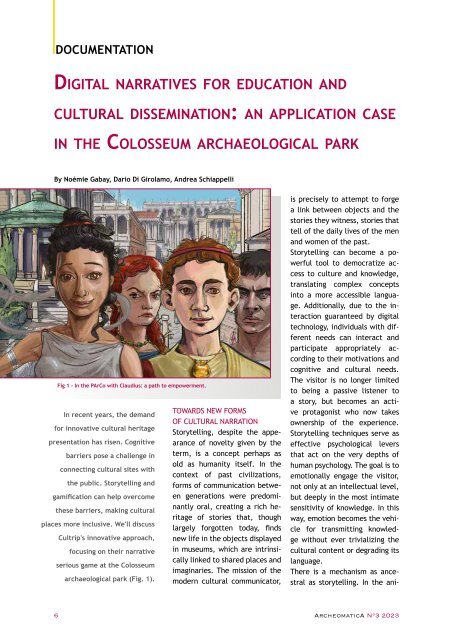Archeomatica_3_2023
ggfdhsd
ggfdhsd
Create successful ePaper yourself
Turn your PDF publications into a flip-book with our unique Google optimized e-Paper software.
DOCUMENTATION<br />
Digital narratives for education and<br />
cultural dissemination: an application case<br />
in the Colosseum archaeological park<br />
By Noémie Gabay, Dario Di Girolamo, Andrea Schiappelli<br />
Fig 1 - In the PArCo with Claudius: a path to empowerment.<br />
In recent years, the demand<br />
for innovative cultural heritage<br />
presentation has risen. Cognitive<br />
barriers pose a challenge in<br />
connecting cultural sites with<br />
the public. Storytelling and<br />
gamification can help overcome<br />
these barriers, making cultural<br />
places more inclusive. We'll discuss<br />
Cultrip's innovative approach,<br />
focusing on their narrative<br />
serious game at the Colosseum<br />
archaeological park (Fig. 1).<br />
TOWARDS NEW FORMS<br />
OF CULTURAL NARRATION<br />
Storytelling, despite the appearance<br />
of novelty given by the<br />
term, is a concept perhaps as<br />
old as humanity itself. In the<br />
context of past civilizations,<br />
forms of communication between<br />
generations were predominantly<br />
oral, creating a rich heritage<br />
of stories that, though<br />
largely forgotten today, finds<br />
new life in the objects displayed<br />
in museums, which are intrinsically<br />
linked to shared places and<br />
imaginaries. The mission of the<br />
modern cultural communicator,<br />
is precisely to attempt to forge<br />
a link between objects and the<br />
stories they witness, stories that<br />
tell of the daily lives of the men<br />
and women of the past.<br />
Storytelling can become a powerful<br />
tool to democratize access<br />
to culture and knowledge,<br />
translating complex concepts<br />
into a more accessible language.<br />
Additionally, due to the interaction<br />
guaranteed by digital<br />
technology, individuals with different<br />
needs can interact and<br />
participate appropriately according<br />
to their motivations and<br />
cognitive and cultural needs.<br />
The visitor is no longer limited<br />
to being a passive listener to<br />
a story, but becomes an active<br />
protagonist who now takes<br />
ownership of the experience.<br />
Storytelling techniques serve as<br />
effective psychological levers<br />
that act on the very depths of<br />
human psychology. The goal is to<br />
emotionally engage the visitor,<br />
not only at an intellectual level,<br />
but deeply in the most intimate<br />
sensitivity of knowledge. In this<br />
way, emotion becomes the vehicle<br />
for transmitting knowledge<br />
without ever trivializing the<br />
cultural content or degrading its<br />
language.<br />
There is a mechanism as ancestral<br />
as storytelling. In the ani-<br />
6 ArcheomaticA N°3 <strong>2023</strong>

















